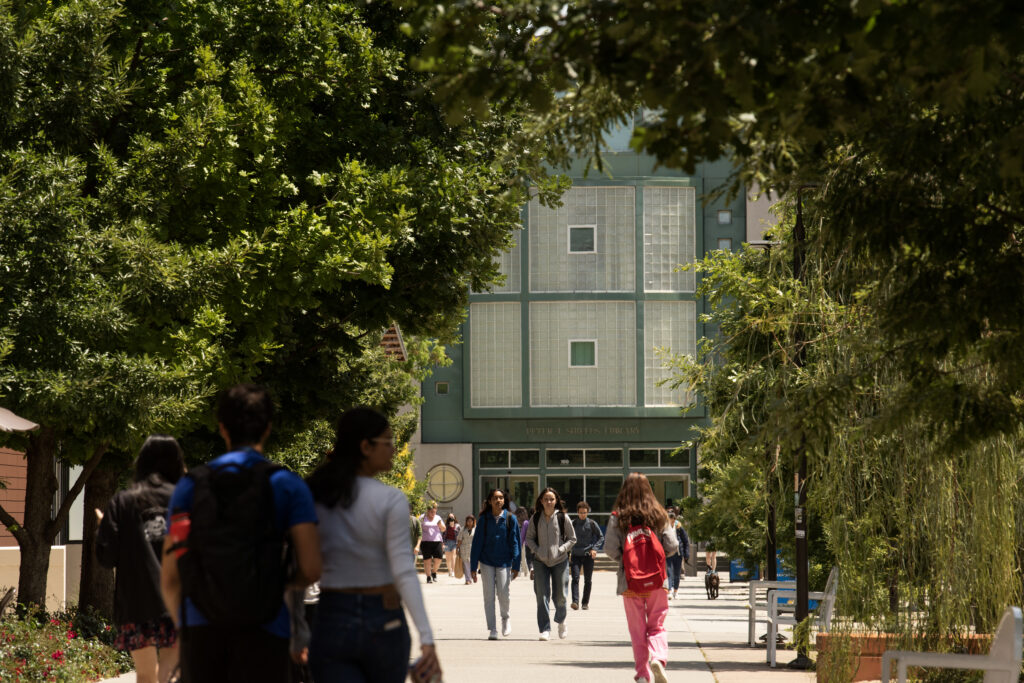
Student walk up and down the Promenade to Shields Library at UC Davis.
Credit: Gregory Urquiaga / UC Davis
The University of California increased enrollment of in-state students by more than 4,000 this past fall, keeping with demands from lawmakers and Gov. Gavin Newsom to grow the number of California residents who get a coveted spot at the university system.
Not only did UC enroll a record number of Californians and its largest-ever class of California first-year students, but the rate of increase for those students was higher than in recent years, when UC has often seen only modest growth.
That freshman class had 42,058 Californians — or 2,094 more than the previous fall. In addition to the uptick in first-years, UC enrolled more returning in-state sophomores, juniors and seniors than the previous year. Overall, UC enrolled 194,571 California resident undergraduates — or 4,145 more than fall 2022, a 2.2% jump. That accounted for 83.4% of UC’s total undergraduate enrollment. Enrollment of out-of-state students declined, thanks to a drop in the number of returning international students.
The historic jump in California residents is a turnaround from last year when lawmakers were critical of UC for failing to meet their demands.
Campuses that welcomed an increase in California freshmen last fall are: Santa Cruz, Irvine, Davis, UCLA, San Diego and Santa Barbara. Berkeley and Merced saw only modest increases. When including returning students, the largest increases of California residents happened at the Berkeley, Los Angeles and San Diego campuses. UC officials cited higher retention rates as being among the main drivers of those increases.
“When we take a look at California resident students, this is the largest number that we’ve ever had,” Pamela Brown, UC’s vice president of institutional research and academic planning, said on a call with reporters this week.
Over the last several years, UC has faced pressure from lawmakers and Newsom to prioritize enrollment of California resident undergraduates. In 2022, Newsom implemented a multiyear agreement — or a “compact” — with the system. Under the agreement, Newsom pledged annual budget increases of 5% in exchange for increased enrollment of in-state students, among other things.
The system at times has struggled to keep up with those requests, with higher numbers of admitted California residents not always translating to enrollments in recent years.
UC officials maintain they are committed to continue growing enrollment of California residents, even though Newsom earlier this month proposed deferring $258.8 million in state dollars for UC until 2025. That includes the funding for a 5% increase to UC’s base budget that the system is supposed to receive as part of the compact.
“We’re all in on the compact,” Brown said.
UC also enrolled a more racially diverse student body this past fall. Across the undergraduate student body, the share of students from underrepresented racial groups — including Black, Latino, Native American and Pacific Islander students — grew by 1.1% or 3,481 students. By far, the largest increase was among Latino students. UC enrolled 61,075 Latino students, 2,671 more than the previous fall, with California residents making up the vast majority of those students.
UC achieved the increases despite a small decline in California residents transferring from a California community college, with the number of first-time transfer students down by 72. That decline, however, was much more modest than the previous year, when the number of in-state residents who transferred from a California community college declined by more than 1,000 students.
Officials have attributed the drop in transfer students to declines in the number of students attending community colleges, which suffered massive enrollment losses during the pandemic. But with enrollment at the state’s community colleges now showing signs of recovery, those trends could be reversing.
“We feel that this is something that is going to continue to improve in the next few years,” Brown said.
UC’s optimistic estimates for in-state enrollment marks somewhat of a contrast from just a year ago, when UC told lawmakers it was behind schedule in increasing the enrollment of those students. UC estimated at the time that its enrollment of in-state students would decrease in the 2022-23 academic year, frustrating lawmakers who had asked UC to add thousands of California residents.
In fact, though, UC ended up increasing enrollment of California residents on a full-time equivalent basis by more than 1,500 students in 2022-23, officials said this week. That was because students took more classes in the spring and winter than UC had anticipated.
The full-time equivalent calculation is different from headcount enrollment, which is a simple count of the total number of students. The number of full-time equivalent students, which is how the state calculates enrollment for funding purposes, is based on the total number of credits that students take. Under the multi-year agreement with Newsom, UC is expected to have added 8,000 full-time equivalent resident undergraduates by 2026-27, with 2022-23 serving as the baseline.
UC won’t know its 2023-24 full-time equivalent enrollment numbers until the end of the academic year, but the increase in headcount enrollment in fall 2023 suggests that number is continuing to trend upward.
And even though UC is funded based on its full-time equivalent enrollment, lawmakers are just as concerned with ensuring the system continues to increase the total number of residents who attend.
The university’s plans for sustained enrollment growth does raise the question of whether its campuses have the capacity for that growth, particularly with some campuses already facing housing shortages.
During this week’s call with reporters, officials cited new housing projects that are underway at several campuses and noted that future new students may not all be attending UC’s traditional brick-and-mortar campuses.
“We are evaluating opportunities for students to pursue their degrees through things like our University of California in DC program, through our Sacramento program, which may not have direct footprints on campuses, but still allow them to have the in-person educational experience,” said Ryan King, a spokesperson for the system.
King added that UC will also look to increase online offerings.
Brown also noted that the compact with Newsom has provided the “stability of knowing what we’re getting” and will help support enrollment growth.
This year, under Newsom’s proposed budget deferrals, UC would be asked to borrow money to cover its compact funding — $227.8 million, plus another $31 million to increase resident enrollment and offset declines in the enrollment of nonresidents, who pay more tuition.
In his budget proposal, Newsom said UC would get reimbursed in next year’s state budget. In its analysis of Newsom’s budget, the Legislative Analyst’s Office warned that plan could be risky.
“Not only would this proposal increase the pressure on the state to provide these payments next year—despite continued deficits — but it also would shift fiscal risk to these entities in the event the state does not ultimately make these payments,” the LAO wrote.
Brown, though, said UC remains confident in the compact and noted campuses are already moving forward with their 2024-25 enrollment planning, when UC expects to further increase California resident enrollment.
“Campuses have set out targets that are helping us achieve the compact goals, and we’re continuing with those,” Brown said. “All our enrollment planning functions are looking to achieve the compact goals, and we are expressing great confidence that we’ll continue to get that support from the state.”





